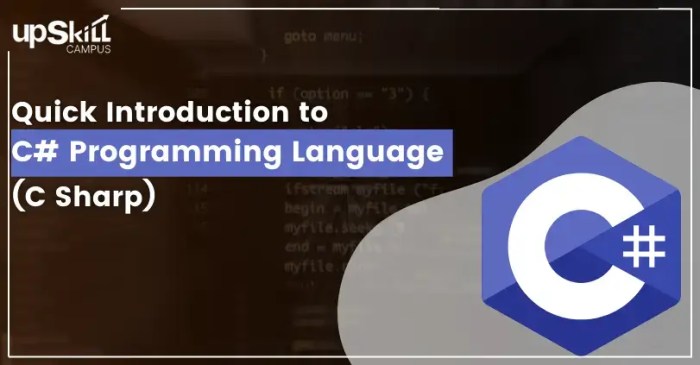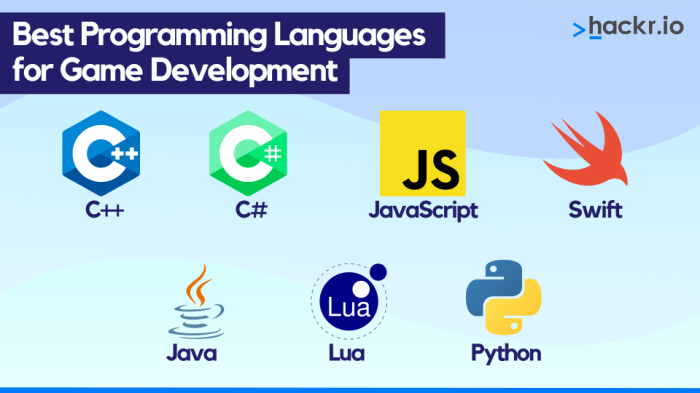Best Programming Language Learn First For Beginners
Best programming language learn first for beginners, a crucial question for aspiring coders. This guide explores the landscape of popular languages, helping you choose the right starting point for your programming journey. From understanding fundamental concepts to exploring various project applications, we’ll provide a comprehensive overview.
The journey to becoming a proficient programmer often begins with selecting the right language. This document will dissect various options and provide clear insights, considering different learning styles and career aspirations.
Introduction to Programming Languages

Source: upskillcampus.com
Programming languages are the tools we use to communicate instructions to computers. Understanding different languages and their characteristics is crucial for choosing the right one for a specific task, especially for beginners. This section provides a foundational overview of programming languages, highlighting key concepts and examples.Different programming languages cater to various needs and purposes. Some are tailored for web development, others for data science, and some for general-purpose tasks.
This introduction will focus on languages suitable for beginners, exploring their common features and contrasting them.
Overview of Programming Languages for Beginners
Various languages are suitable for beginners, each with its own strengths and learning curve. Popular choices include Python, JavaScript, and Java. Each of these languages offers a different approach to problem-solving and is suited for diverse applications.
- Python: Python is renowned for its readability and simplicity. Its syntax is designed to be easily understood, making it an excellent choice for beginners. This allows for faster learning and focus on programming concepts rather than complex syntax.
- JavaScript: JavaScript is a versatile language primarily used for front-end web development. It enables dynamic interactions on websites. While it has a steeper learning curve than Python, it offers significant career opportunities.
- Java: Java is a powerful, object-oriented language widely used for developing applications, especially enterprise-level software. Its robust structure makes it suitable for large projects but requires a more comprehensive learning process.
Common Characteristics and Differences
Most programming languages share fundamental elements, including variables, data types, operators, and control structures. However, their syntax, style, and underlying philosophies vary. For example, Python emphasizes code readability with its indentation-based structure, while Java employs a more rigid, class-based structure.
- Variables: Variables are used to store data. Each language defines rules for naming variables and their data types (e.g., integers, strings, floating-point numbers). Python allows for dynamic typing, whereas Java is statically typed.
- Control Structures: These include loops (like `for` and `while`) and conditional statements (like `if-else`) to control the flow of execution. The implementation and syntax of these structures differ across languages.
- Data Types: Languages define various data types to represent different kinds of information (numbers, text, booleans). The range and specific implementations of data types differ between languages.
Beginner-Friendly Syntax Examples
Understanding basic syntax is essential for any beginner. Here are simplified examples demonstrating common operations.
- Python:
“`python
name = “Alice”
age = 30
print(“Hello, ” + name + “! You are ” + str(age) + ” years old.”)
“` - JavaScript:
“`javascript
let name = “Bob”;
let age = 25;
console.log(“Hello, ” + name + “! You are ” + age + ” years old.”);
“` - Java:
“`java
public class Main
public static void main(String[] args)
String name = “Charlie”;
int age = 22;
System.out.println(“Hello, ” + name + “! You are ” + age + ” years old.”);“`
Comparison of Popular Languages, Best programming language learn first for beginners
This table summarizes the learning curve, strengths, and weaknesses of three prominent beginner languages.
| Language | Learning Curve | Strengths | Weaknesses |
|---|---|---|---|
| Python | Relatively easy | Readability, versatility, extensive libraries | Can be slower for computationally intensive tasks |
| JavaScript | Moderate | Web development focus, interactive elements | Can become complex with large projects, browser compatibility issues |
| Java | Steeper | Platform independence, robust applications | More complex syntax, can be slower to learn object-oriented concepts |
Choosing the Right Language: Best Programming Language Learn First For Beginners
Deciding on your first programming language is a crucial step. It sets the foundation for your learning journey and influences your future career prospects. Choosing wisely ensures that you invest your time and effort in a language that aligns with your goals and provides a solid foundation for future development.Understanding the factors involved in selecting the ideal language for beginners is essential.
This includes considering personal interests, career aspirations, and the language’s suitability for various tasks. The correct selection can significantly impact your learning experience and future opportunities.
Factors to Consider When Choosing a Language
A beginner’s selection of a programming language should consider several factors. These factors include the language’s ease of learning, its potential applications, and its community support. A language that aligns with your interests and career goals will make learning more engaging and rewarding.
- Ease of Learning: Some languages are inherently easier to grasp than others, especially for beginners. Factors like syntax clarity and abundant online resources contribute to a smoother learning curve.
- Potential Applications: The language’s versatility and potential uses should align with your future interests. Consider whether the language can be applied to web development, game development, or data science, among other fields.
- Community Support: A robust community provides valuable support, guidance, and resources. Active forums and online communities make learning more collaborative and enjoyable.
- Career Paths: The chosen language should be aligned with potential career paths. Some languages, like Python, are popular in data science, while JavaScript is crucial for web development.
Importance of Programming Fundamentals
Learning fundamental programming concepts is critical regardless of the language chosen. Understanding core concepts like variables, data types, loops, and conditional statements lays a strong foundation. This ensures that you can easily adapt to new languages in the future.Mastering the fundamental concepts of programming is a crucial stepping stone in the journey of becoming a proficient programmer. A robust understanding of these concepts provides a solid base, enabling easier transitions to more advanced topics and languages.
Comparing Potential Career Paths
Different programming languages are associated with various career paths. Python, for example, is widely used in data science and machine learning, while JavaScript is essential for front-end web development. Understanding the potential career trajectories can help beginners choose a language that aligns with their future aspirations.
- Data Science: Languages like Python are highly sought after in this field, due to their extensive libraries and frameworks for data analysis and machine learning.
- Web Development: JavaScript is a dominant force in web development, crucial for both front-end and back-end functionalities.
- Mobile App Development: Languages like Java and Swift are frequently used for creating applications for mobile devices.
Decision-Making Flowchart
A flowchart can guide beginners in selecting the right language. It should consider their interests, learning preferences, and potential career goals. 
The flowchart visualizes the decision-making process by guiding beginners through a series of questions about their interests, learning style, and career aspirations, ultimately leading to a recommended programming language.
Pros and Cons of Popular Languages
The following table provides a comparison of pros and cons for Python and JavaScript, two popular choices for beginners.
| Language | Pros | Cons |
|---|---|---|
| Python | Readability, vast libraries, beginner-friendly syntax, versatile applications (data science, web development). | Can be slower than compiled languages, not as performant for complex tasks. |
| JavaScript | Dominant in web development, vast ecosystem of frameworks and libraries, interactive web applications. | Steeper learning curve for beginners due to asynchronous nature, potential for complex debugging. |
Python for Beginners
Python is a versatile and beginner-friendly programming language known for its clear syntax and extensive libraries. Its readability makes it an excellent choice for those new to programming, allowing them to focus on the logic of a program rather than getting bogged down in complex syntax. Python’s broad applicability spans various domains, from web development to data science, making it a valuable skill to acquire.Python’s core strengths lie in its simplicity and ease of use.
This translates into faster development times and reduced debugging efforts, critical factors for new programmers. The abundance of readily available resources and supportive communities further enhances the learning experience.
Fundamental Concepts of Python Programming
Python uses a simple syntax that emphasizes readability. This is achieved through the use of indentation to define code blocks, a feature that contrasts with languages that rely on curly braces. Understanding indentation is fundamental to writing correct and functional Python code. Data types, such as integers, floating-point numbers, strings, and lists, are crucial for representing and manipulating information within programs.
Variables, acting as named containers for data, facilitate storage and retrieval of values during program execution.
Python Usage in Beginner Projects
Python excels in various beginner projects due to its straightforward syntax and readily available libraries. Simple games, like text-based adventures or number guessing games, are excellent starting points. These projects allow learners to grasp core programming concepts like loops, conditional statements, and functions. Data analysis tasks, such as calculating statistics from datasets or visualizing trends, are also well-suited for Python’s capabilities.
Python Syntax and Structure
Python’s syntax emphasizes readability and clarity. Indentation is crucial; it defines code blocks, unlike languages that use curly braces. Variables, used to store data, follow a simple naming convention. s like `if`, `else`, `for`, and `while` control program flow, allowing for conditional execution and repetitive tasks. Functions, reusable blocks of code, enhance program organization and maintainability.
Importance of Python Libraries for Beginners
Python’s extensive collection of libraries significantly aids beginners. Libraries like NumPy and Pandas simplify data manipulation and analysis. NumPy provides efficient numerical computing capabilities, while Pandas facilitates data manipulation and analysis with its DataFrame structure. These libraries free beginners from writing extensive code for fundamental data handling tasks. This allows them to focus on the problem-solving aspects of data analysis.
Python Applications in Diverse Fields
Python’s versatility is reflected in its wide range of applications. Its usage spans various fields.
| Field | Application |
|---|---|
| Web Development | Creating dynamic websites and web applications |
| Data Science | Data analysis, machine learning, and visualization |
| Machine Learning | Building and training machine learning models |
| Game Development | Creating interactive games |
| Scripting | Automating tasks and system administration |
JavaScript for Beginners
JavaScript is a versatile and powerful programming language primarily used for adding interactivity and dynamic behavior to websites. It’s crucial for modern web development, allowing websites to respond to user actions, update content without reloading the page, and create engaging user experiences. Its widespread adoption and large community make it an excellent language for beginners to learn.
Fundamental Concepts of JavaScript Programming
JavaScript operates on the principle of object-oriented programming (OOP). This allows for the creation of reusable code and complex programs structured around objects. Understanding core concepts like variables, data types, operators, and control flow structures is foundational to any JavaScript program. Variables store data, data types define the kind of data a variable holds (numbers, strings, booleans, etc.), operators perform actions on data, and control flow structures (if-else statements, loops) determine the order of execution.
These elements combine to create dynamic and interactive web applications.
JavaScript in Web Development Projects
JavaScript plays a central role in enhancing the functionality of web pages. It’s responsible for tasks like handling user input, validating forms, updating content dynamically, and communicating with servers. A common example is a form submission that verifies data before sending it, preventing errors. Another key application is displaying real-time updates, like a chat application, where new messages appear without requiring a page reload.
JavaScript Syntax and Structure
JavaScript employs a syntax similar to other programming languages, but with its own distinct characteristics. It uses curly braces “ to define code blocks, semicolons `;` to separate statements, and s like `var`, `let`, and `const` to declare variables. JavaScript code is typically embedded within HTML documents, often in `










